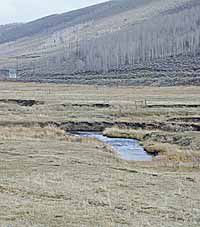| Conservation easements are often placed on areas where agriculture or ranching have been prevalent for years. |
A recent advertisement for a clothing retailer portrays a grieving family watching a video of a departed grandma figure telling the family that she is leaving all her money to a single grandson provided that he starts dressing better. The spot goes on to show him traveling to the advertisers store, getting new clothes and looking rather sharp when he returns home. Waiting for him at the door is his supposedly departed grandma and as the camera shows his surprised face as she tells him it was the only way the family could get him to dress better.
In the case of this advertisement, the manipulative efforts of a grandma does change the behavior of the young man, much to his chagrin. Of course what happens after the ad is over demands a great deal of conjecture, because one can never be sure how ones actions will change the future. Good intentions can often backfire, especially when dealing with the unknown.
In some experts minds, the move toward conservation easements, or conservation servitudes as they are also known, on private property, may be good for those who initially put the legal restrictions on their own land, but in the long run will they serve the public good, the environment or future owners of that same property? Just as in the case of the advertisement, it is hard to tell what the actual outcome will be.
Private property rights are one of the basic rights American citizens have. In the history of the world, no nation has ever granted so many private property rights to so many citizens, rich and poor, famous and obscure, powerful and weak. No nation, either, has ever been rich or so influential in the world as America.
The right to private property is guaranteed in the constitution, and still is a basic premise for much of American life, as well as the American dream. However, over the years many kinds of challenges have faced property ownership.
Some of those challenges include issues such as zoning laws and split estates. But conservation easements are a whole new type of challenge that many state governments, including Utah’s, have taken to heart for what seems good purposes.
Proponents of conservation easements often see the American system of private property as detrimental to the environment. After all, the American way is to own property and in some way increase it’s value. Most of the time that is done either by holding it for a time (speculation) or by doing some type of development to it. But by even just holding it, may be a type of development because most speculation is based on possible future development of some kind. That means private property which nondevelopment groups value as environmentally or culturally resource important, for one reason or another, can have directions changed on it at the whim of the owner. This causes the appearance that private property, without restriction, is bad for preservation.
For most of these groups outright government ownership would be the best option to protect it, but that can’t always happen due to financial constraints on buying all the property that they think should be protected. Besides, critics point out that the absence of private property actually does not always protect the environment. They usually bring up the example of the environmental disasters the Soviet Union and other communist countries are still suffering from because of the lack of care people had for lands they did not own.
But more of a concern than that to some people is what could happen should conservation easements, which are being placed on property almost daily somewhere in the United States, is what their effect might be on future generations.
“I worry that we might end up with kings forests in this country,” says Dave Levanger, the director of planning and zoning for Carbon County. “With a conservation easement a person could get out of paying most of the taxes on a property, and yet still own it while taxpayers take care of and maintain it.”
For instance, under such programs as the Forest Legacy program a wealthy individual can purchase a ranch and then offer them to the government. The land is appraised and the federal government buys the development rights easement for 75 percent of the fair market value. The owner still has the right to build some cabins and other things on the property, but is left with a private hunting or recreational preserve.
It could happen, and Levanger even worries more about how the use of the Endangered Species Act could spread a conservation easement over many acres of property that were not intended to be protected by the original servitude.
“Imagine one piece of land that is protected by a conservation easement and an endangered species is found to exist there,” says the county official. “By the way the law works the protection from development or even many types of use could spread almost where ever that species roams or exists. That could lead to large areas of land having no value for future owners.”
That brings up the future and how conservation easements may be construed at that time. Does the present generation have the right to make choices for future generations of private land owners? Conservation easements are granted in perpetuity, and are designed to keep anyone from tampering with them. Most people seem to believe that today’s generation is smarter than any generation of the past, but with that type of thinking, how can they believe that they can make good choices for future generations.
It’s a lot like ones grandma tricking them into doing something, something in which the results may be questionable.

